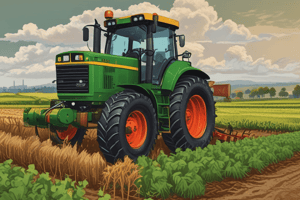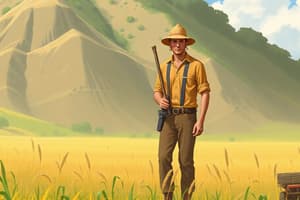Podcast
Questions and Answers
What is the term for growing a single crop on a large area of land?
What is the term for growing a single crop on a large area of land?
- Inter cropping
- Monoculture (correct)
- Polyculture
- Crop rotation
Which of the following is NOT a phase of crop production?
Which of the following is NOT a phase of crop production?
- Fertilization (correct)
- Harvesting
- Seeding
- Land preparation
What is the term for growing two or more crops together, often with different growth habits?
What is the term for growing two or more crops together, often with different growth habits?
- Inter cropping (correct)
- Monoculture
- Polyculture
- Crop rotation
What is the term for rotating different crops on the same land to maintain soil fertility and reduce pests and diseases?
What is the term for rotating different crops on the same land to maintain soil fertility and reduce pests and diseases?
What is the term for the physical and nutritional characteristics of a crop?
What is the term for the physical and nutritional characteristics of a crop?
Which of the following is a factor that affects crop production?
Which of the following is a factor that affects crop production?
What is the term for using technology, such as GPS and drones, to optimize crop production?
What is the term for using technology, such as GPS and drones, to optimize crop production?
What is the term for collecting the mature crops, including manual or mechanical methods?
What is the term for collecting the mature crops, including manual or mechanical methods?
Flashcards are hidden until you start studying
Study Notes
Crop Cultivation and Production
Types of Crop Cultivation
- Monoculture: growing a single crop on a large area of land
- Polyculture: growing multiple crops together on the same land
- Inter cropping: growing two or more crops together, often with different growth habits
- Crop rotation: rotating different crops on the same land to maintain soil fertility and reduce pests and diseases
Crop Production Phases
- Land preparation: preparing the soil for planting, including plowing, fertilizing, and irrigation
- Seeding: planting seeds at the correct depth and spacing
- Growth stage: crop growth, including germination, vegetative growth, and reproductive growth
- Maturation: crops reach maturity and are ready for harvest
- Harvesting: collecting the mature crops, including manual or mechanical methods
Factors Affecting Crop Production
- Climate: temperature, precipitation, and solar radiation affect crop growth and yield
- Soil: soil type, pH, nutrient availability, and water holding capacity impact crop growth
- Water: irrigation, rainfall, and water stress affect crop growth and yield
- Pests and diseases: weeds, insects, and diseases can reduce crop yields and quality
- Farm management: crop selection, planting date, and farming practices influence crop production
Crop Production Systems
- Conventional farming: using synthetic fertilizers, pesticides, and irrigation
- Organic farming: using natural fertilizers, pest control methods, and crop rotation
- Sustainable agriculture: using practices that minimize environmental impact, such as conservation agriculture and agroforestry
- Precision agriculture: using technology, such as GPS and drones, to optimize crop production
Crop Yield and Quality
- Yield: the quantity of crop produced per unit of land
- Quality: the physical and nutritional characteristics of the crop, such as size, color, and nutrient content
- Post-harvest handling: storing, processing, and packaging crops to maintain quality and reduce losses
Crop Cultivation and Production
Types of Crop Cultivation
- Monoculture involves growing a single crop on a large area of land, often leading to soil depletion and increased pest vulnerability.
- Polyculture, on the other hand, involves growing multiple crops together, promoting biodiversity and reducing soil erosion.
- Inter cropping involves growing two or more crops together with different growth habits, allowing for efficient use of land and resources.
- Crop rotation involves rotating different crops on the same land to maintain soil fertility, reduce pests and diseases, and promote ecosystem balance.
Crop Production Phases
- Land preparation involves plowing, fertilizing, and irrigating the soil to create a suitable environment for planting.
- Seeding requires planting seeds at the correct depth and spacing to ensure optimal growth.
- The growth stage includes germination, vegetative growth, and reproductive growth, and is critical for crop development.
- Maturation marks the point at which crops reach their full potential and are ready for harvest.
- Harvesting involves collecting mature crops, which can be done manually or mechanically, depending on the crop and available resources.
Factors Affecting Crop Production
- Climate factors, such as temperature, precipitation, and solar radiation, significantly impact crop growth and yield.
- Soil type, pH, nutrient availability, and water holding capacity all influence crop growth and productivity.
- Water availability, including irrigation and rainfall, affects crop growth and yield, with water stress potentially reducing crop quality.
- Pests and diseases, such as weeds, insects, and diseases, can reduce crop yields and quality, and must be managed effectively.
- Farm management practices, including crop selection, planting date, and farming techniques, also influence crop production.
Crop Production Systems
- Conventional farming relies on synthetic fertilizers, pesticides, and irrigation to maximize yields, but may have negative environmental impacts.
- Organic farming, on the other hand, uses natural fertilizers, pest control methods, and crop rotation to promote ecosystem balance.
- Sustainable agriculture seeks to minimize environmental impact through practices such as conservation agriculture and agroforestry.
- Precision agriculture leverages technology, including GPS and drones, to optimize crop production and reduce waste.
Crop Yield and Quality
- Crop yield refers to the quantity of crop produced per unit of land, and is influenced by factors such as climate, soil, and farm management.
- Crop quality encompasses physical and nutritional characteristics, such as size, color, and nutrient content.
- Post-harvest handling, including storage, processing, and packaging, is critical for maintaining crop quality and reducing losses.
Studying That Suits You
Use AI to generate personalized quizzes and flashcards to suit your learning preferences.




